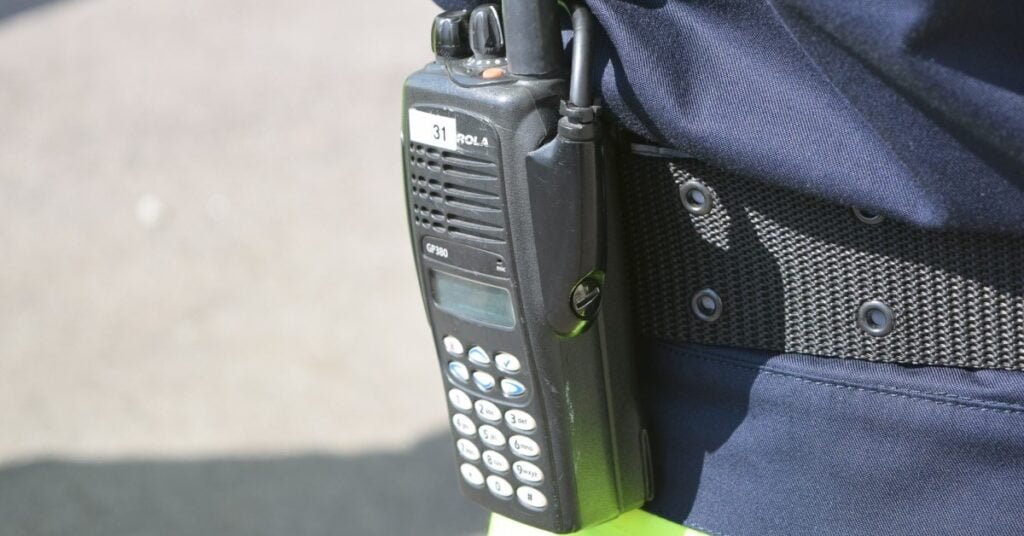Table of Contents
ToggleThe Walkie Talkies Behind the Badge: What Walkie Talkies Do Police Use?
If we picture what a police officer looks like during action, one of the most iconic scenes is them gripping their walkie-talkies. They are communicating important bits of information to their co-workers. Communication is vital to police enforcement operations. This includes organizing a high-speed pursuit, asking for assistance, or obtaining intelligence. But these are no run of the mill walkie-talkies bought off the shelf. Cops rely on customized, very durable ones with enhanced capabilities to stay linked via secure, trustworthy channels. They also employ sophisticated police scanner frequencies, which are essential for handling and monitoring a variety of circumstances.
We will take a closer look at the key elements of police walkie-talkies, as well as how they interact with police scanner frequencies and why these communication devices are so critical in law enforcement. The case with the FE series radios is no exception, and here we discuss some of those key features that have made them a lifeline for the men (and women) behind the badge.
The Heavy-Duty Need: Durability in the Field

Police officers endure a variety of situations on the job, from foot pursuits in rainstorms to aiding at accident scenes. That implies their equipment must be as robust as their responsibilities require. Police walkie-talkies are specifically intended to resist difficult situations, therefore durability is a primary consideration.
Unlike consumer-grade radios, police enforcement walkie-talkies are frequently waterproof, shockproof, and impact resistant. They are designed to withstand drops, harsh handling, and exposure to the outdoors without sacrificing functionality. This level of durability assures that cops can rely on their radios in high-stress, dangerous circumstances. They can perform well regardless of environmental conditions.
Because of their increased longevity, these radios operate well when tuned to police scanner frequencies. Officers use these frequencies to stay updated on area activities, including possible threats or emergencies.
However, if you want to know about the price range walkie-talkie models shown as an FM wireless scanner such as Baofeng UV-5R, from here on over this link is where you can get information in great detail about the little beast.
Clarity in Communication: Life or Death
Clear communication is vitally essential in police operations. Miscommunication or poor audio quality can have disastrous implications. This can happen whether officers fail to call for assistance in time or misinterpret orders in the heat of the moment. As a result, police enforcement walkie-talkies use advanced audio processing technologies.
Many police radios have noise-canceling microphones that eliminate background sounds such as traffic, sirens, and wind. These gadgets guarantee that an officer’s voice be heard clearly even in noisy surroundings. This is where police scanner frequencies come into play. Effective communication on certain frequencies is critical to ensuring that officers receive and send information accurately.
The radios also feature several sound clarity settings. These allow them to change automatically based on surrounding noise, saving officers from struggling with settings during emergencies. The next time you hear about police scanner frequencies in a conversation about police radios, remember that the quality of the broadcast has a direct influence on the officer’s ability to act quickly and efficiently.
Communication clarity depends on many factors. Some frequencies work through barriers like walls, while others do not. Click here to learn more.
Secure Channels: Police Scanner Frequencies
It is not enough to just communicate in law enforcement; it is also necessary to ensure that only the appropriate persons hear the discourse. When police handle sensitive information such as the location of a sting operation or the description of a suspect, it is critical that their communication lines stay secure.
To protect the privacy and security of their communications, police radios use encrypted channels. Digital coding technology that renders information unreadable to anyone except those in possession of the correct decryption key This ensures that potential thieves or hackers do not get to eavesdrop on broadcasting at police scanner frequencies, which could allow them access critical law enforcement conversations.
Without these encrypted lines, anybody with access to a scanner may eavesdrop on police talks, jeopardizing investigations and endangering officers and the public. Encryption technology allows police enforcement to communicate freely without fear of compromising security.
You can also enhance the security of your wireless communication, such as ham radio communication, by using privacy codes. Click here to learn more about privacy codes and how to use them.
Long-Range Capability: Staying Connected Across Large Areas

Police personnel work in a range of settings, including crowded metropolitan centers, rural roadways, and distant locations. Regardless of where they are, they must maintain strong, clear contact with their dispatch and other officers. That is why police walkie-talkies have good range, allowing for long-distance communication.
These radios often operate on numerous bands and frequencies, allowing them to convert effortlessly between local and long-distance modes. Some types employ repeaters—devices that take up a signal and rebroadcast it over a larger area—to extend connection even further. This is especially beneficial when cops are in areas where direct radio contact would normally be restricted.
Having access to police scanner frequencies over vast distances allows cops to listen in on crucial information and alerts no matter where they are. Whether they are patrolling a distant roadway or responding to a call on the other side of town, they can stay connected and informed.
Curious about how far a mobile walkie-talkie can transmit your voice and communicate with others? Find out here.
Battery Life Of Police Scanner Frequencies
The usual police shift lasts between 8 and 12 hours, although in emergency situations or large-scale operations, it can last much longer. During these extended hours, cops rely on their radios to stay operating without having to constantly recharge them. That’s why battery life is so important in police walkie-talkies.
Modern police radios employ high-capacity lithium-ion batteries, which give long-lasting power while being lightweight. These batteries are designed to last the full shift, even with intensive use. Some radios additionally include battery-saving modes, which save power by decreasing device activity during inactive periods.
When police personnel need to monitor police scanner frequencies throughout their shift, consistent battery performance is essential. It guarantees that lines of communication remain available at all times. A radio that fails in the middle of operation may result in missing information, delayed answers, and compromised safety.
Experiencing fast battery drain on your ham device? It’s time for some troubleshooting. Click here for detailed steps on how to address the issue.
Common Walkie-Talkie Models Used by Police
Police agencies may employ a number of radio devices based on their needs and geography. However, a few important types are popular with police enforcement because of their durability, range, and technological functionality. These variants are also tuned for tuning into police scanner frequencies, resulting in clear and secure communication.
Motorola APX Series
Motorola’s APX radios are among the most often utilized by police agencies globally. These radios are noted for their sturdy design, which can survive severe situations while providing crystal-clear music. With built-in encryption and multi-band capabilities, the APX series ensures safe communication across a wide variety of frequencies, including crucial police scanner frequencies. The lengthy battery life and user-friendly UI make them popular among law enforcement officers.
Kenwood NX-5000 Series
Kenwood radios are another popular choice among police forces. The NX-5000 series is multi-band capable, which means it can communicate across many channels and frequencies, which is an important feature when working with other agencies. Kenwood radios provide clear audio and reliable encryption to maintain communication security. Their design enables cops to remain linked to police scanner frequencies, particularly in multi-agency operations when coordination is critical.
Harris XL-200P
The Harris XL-200P is a multiband, multi-mode radio designed for versatility and dependability. It is highly acclaimed for its strong encryption and long-distance communication capabilities. Whether officers are on patrol in urban or rural regions, the XL-200P provides constant performance on police scanner frequencies, making it a top choice for maintaining situational awareness.
How Officers Remain Informed — Tuning Into Police Scanner Frequencies

In addition to two-way communication, police radios allow officers to hear multiple different police scanner channels with information in real time. For example, these frequencies are used to direct 911 calls into the Dispatch Center as well as reports of ongoing incidents from other police or agencies. The ability to scan multiple frequencies simultaneously enables police to get a jump on announcements and rapidly respond in emergency situations.
Police scanner frequencies differ by jurisdiction and purpose, but having access to a diverse range of frequencies is crucial in fast-paced, unexpected circumstances. Police radio equipment is smart enough to scan numerous frequencies at the same time, prioritizing important messages while also monitoring the overall situation.
In many circumstances, cops use police scanner frequencies to gain a full picture of what’s going on in their area. This capability allows them to respond promptly to significant occurrences or threats.
Learn more about ham radio frequency chat here.
The Future of Cop's Walkie-Talkies: Integrating Advanced Technology
The deepening of the story came when you reported on how law enforcement radios have lagged behind in recent technological advancements. Today, tomorrow and yesterday for police radios is about smart. This could include capabilities like GPS tracking, real-time data push or even video stream. That should lead to better situational awareness and more versatile tools for the cops on the streets.
Furthermore, advances in encryption technology and police scanner frequencies will guarantee that law enforcement communication stays safe and adaptable to new threats, such as cyberattacks or illegal access to critical data.
Final Thoughts: The Lifeline Behind the Badge
The role of police walkie-talkies is beyond just that of a communication device; as this unit works more than a gadget to guarantee the safety and effectiveness when it comes to do their duties by the law. These radios are designed to tackle the unique challenges that law enforcement encounters such as listening in on police scanner frequencies while you can keep a safe, clear line of communication open.
So the next time you see a cop using that walkie-talkie, remember it is more than just an object; but a life-line to allow them to protect and serve our communities with the needed information. Technology certainly continues to change and improve, just like radio advancements perfecting in-car law enforcement radios for decades. This ensures that officers can stay connected, be up to date and ready for whatever may come.


